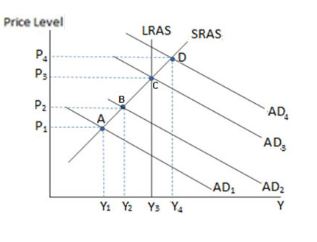Assuming the economy represented in the graph shown is currently at point B, if the government does nothing, then eventually:

A. SRAS will shift to the right, and the economy will have Y3 output with lower prices.
B. SRAS will shift left, and the economy will experience stagflation.
C. LRAS will shift left, until lower equilibrium output is reached with lower prices.
D. the entire economy will collapse.
A. SRAS will shift to the right, and the economy will have Y3 output with lower prices.
You might also like to view...
A margin requirement is
a. the minimum amount of reserves the Fed requires a bank to hold b. the interest rate that the Fed requires from banks who borrow from it c. the marginal interest rate on loans made by banks to other banks d. the maximum percentage of the price of a stock that can be borrowed from a bank, with the stock offered as collateral e. an appeal by the Fed to banks, asking for voluntary compliance with the Fed's policies
Which of the following statements is false? An economic analysis of carbon taxes can:
A. predict the effect on unemployment in West Virginia coal mining communities. B. conclude that such taxes should be imposed to benefit future generations. C. present a trade-off of the costs and benefits of different levels of carbon taxes. D. calculate the increase in costs faced by coal-using industries. compare the likely reductions in medical expenditures on diseases caused by smog.
How will an increase in the world price of crude oil influence the economy of an oil-importing country such as the United States?
A. Aggregate supply will decrease, leading to a decrease in real GDP. B. Aggregate supply will increase, leading to an increase in real GDP. C. Aggregate supply will increase, leading to an increase in prices and smaller GDP. D. A change in the price of an imported good will not affect the domestic economy of an oil-importing country.
An excess demand for euros will cause a depreciation of the euro.
Answer the following statement true (T) or false (F)